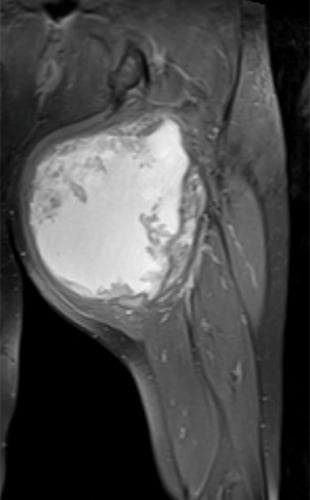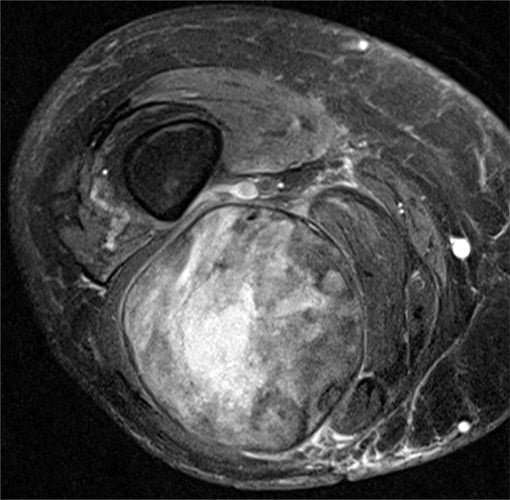Soft-Tissue Sarcoma
What is soft-tissue sarcoma?
Soft-tissue sarcoma is the generic name given to types of cancer that affect the connective tissues in our bodies: muscle, nerves, blood vessels and fats. They can develop anywhere in the body but are often diagnosed in the extremities (arms and legs). "Soft" simply refers to the fact these cancers do not originate in bone, as is the case in osteosarcoma. The designation includes many forms of cancer that are treated similarly and often studied together.
Who gets soft-tissue sarcoma?
The spectrum of soft-tissue sarcoma includes some forms which are more common in children, such as rhadomyosarcoma, and some forms that predominate in older individuals, such as undifferentiated pleomorphic sarcoma. There are certain medical conditions which also predispose an individual to certain forms of soft-tissue sarcoma. For example, patients with neurofibromatosis are more likely to develop a malignant peripheral nerve sheath tumor. Overall these are rare diseases, representing less than 1% of adult cancer cases.
What are the symptoms of soft-tissue sarcoma?
Patients usually notice an enlarging mass or lump in the arm or leg. They may also experience a sense of fullness in that limb as compared with the opposite extremity. The mass is usually painless, leading many to ignore it until it reaches substantial size. If the mass presses on a nearby nerve, it may lead to numbness or tingling in an extremity.
What does a soft-tissue sarcoma look like?
Soft-tissue sarcoma usually looks like a rounded mass beneath the skin surface. The skin is usually unaffected. The mass may be soft or firm. If the mass is deep, the arm or leg may appear larger or fuller than the other side. The tissue itself may appear bland, like scar tissue, or if more disorganized like mucus.

Coronal MRI view of a soft-tissue sarcoma on medial (inner) thigh. The particular cancer type in this image is a fibromyxoid sarcoma.

Axial MRI view of a soft-tissue sarcoma in the thigh, appearing as the prominent white mass. The particular cancer type in this image is a leiomyosarcoma.
Is soft-tissue sarcoma deadly?
Soft-tissue sarcoma is a form a cancer. This means it can spread to other parts of the body, chiefly the lungs, and ultimately prove fatal if growth continues. Treatment is aimed at removing or destroying the cancer prior to it reaching a deadly state.
Do soft-tissue sarcomas grow quickly?
The growth rate of soft-tissue sarcoma is highly variable, but in general it will grow noticeably over weeks to months. Any mass that grows in this time frame needs urgent medical evaluation. Even a mass that grows slowly over years should still be evaluated to determine if cancer is present.
How is soft-tissue sarcoma diagnosed?
Once a mass is discovered, additional radiographic imaging is warranted to better understand it. X-rays are usually negative. Any suspicious mass should be referred to an oncologic surgeon, as even small masses can represent cancer and need to be managed appropriately. An MRI should be obtained of any growing mass to assess its character and true size. A biopsy is then needed to make a diagnosis.
The biopsy can safely be performed in a physician office setting (using a needle) or in an operating room, depending on the size and location of the mass. The biopsy is evaluated by a pathologist to determine if cancer is present, since many masses – even ones with slow growth over time – may be benign. If cancer is present, additional imaging studies are performed to assess for cancer in other parts of the body.
How is soft-tissue sarcoma treated?
Treatment will depend on the diagnosis obtained during the biopsy. Typically, surgical removal the mass by an orthopedic oncologist is an essential part of treatment. Many forms of soft-tissue sarcoma are treated with radiation therapy as well, thus a radiation oncologist is usually part of the treatment team. Some forms of soft-tissue sarcoma also respond to traditional chemotherapy or new emerging therapies (like immunotherapy), so a medical oncologist may also guide treatment. This team of physicians will determine and coordinate the initial treatment.
Once completed, patients are followed closely over time to assess for any signs of recurrent cancer or side effects from the treatment. Because soft-tissue sarcoma is most effectively treated early, it is recommended that patients seek medical attention for any concerning mass or lump.
Medically reviewed by Taylor J. Reif, MD
